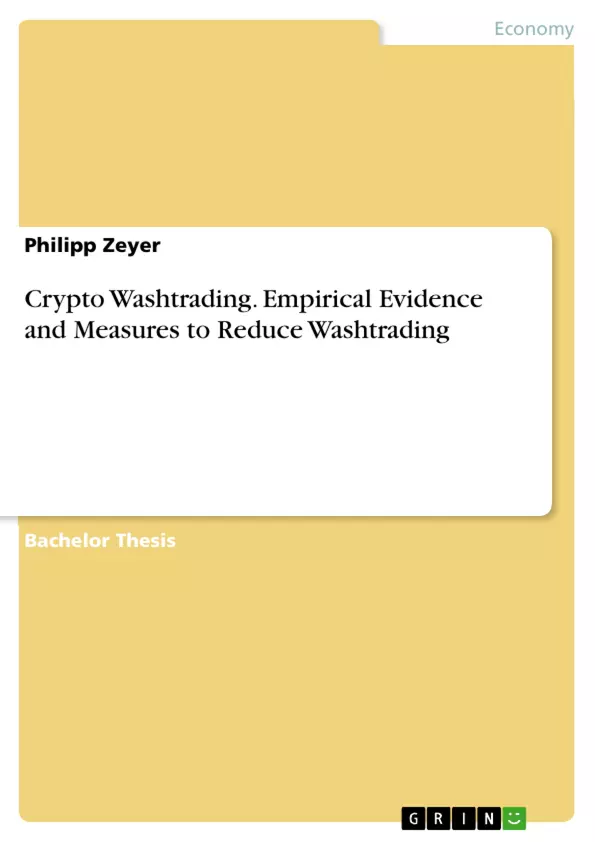This thesis makes use of statistical methods such as the Pearson’s Chi-squared analysis to find significant deviations in the first significant digit distributions in the historical transaction record of selected regulated crypto exchanges compared to Benford’s Law. The analysis of trade size clustering behavior at key round numbers is used in order to detect possible signs of washtrading, followed by the volume spike analysis, where the correlation between the four exchanges in terms of rise and fall of their volume is carefully observed.
Aloosh and Li (2019) and Lin et al. (2021) suggest a divergence between regulated and unregulated exchanges in regards to the washtrading activity, in the sense that most regulated exchanges seemed to confirm most statistical analysis while many unregulated crypto exchanges have shown signs of significant violations.
Opposed to these findings, the focus will lie on regulated crypto exchanges only, for which partly abnormal patterns are in fact found, at least regarding the first significant digit distribution. Furthermore, the various regulatory frameworks for the selected exchanges are illustrated, consisting of Gemini, Bitstamp, Kraken and Zaif. The centre of attention will then shift to showing off possible incentives for the various parties to engage in washtrading in the first place. The thesis lays out how these activities distort exchange ratings and the connected metrics as well as aid in creating illegal schemes such as pump and dumps.
Inhaltsverzeichnis (Table of Contents)
- 1 Introduction
- 2 Background information
- 2.1 The cryptocurrency ecosystem
- 2.2 Regulation of relevant crypto exchanges
- 3 Data
- 4 Empirical Evidence
- 4.1 Benford's Law
- 4.1.1 General
- 4.1.2 Pearson's Chi-Squared Test for Benford's Distribution
- 4.1.3 Statistical Results
- 4.2 Clustering at key psychological numbers
- 4.3 Volume Spike Analysis
- 4.4 Discussion of statistical results
- 4.1 Benford's Law
- 5 Incentives, Perpetrators and Impact
- 6 Measures to reduce washtrading
- 7 Conclusion
- 8 Outlook on future research
- 9 Bibliography
Zielsetzung und Themenschwerpunkte (Objectives and Key Themes)
This thesis aims to investigate the prevalence of washtrading activities on regulated cryptocurrency exchanges by analyzing historical transaction data using statistical methods such as the Pearson's Chi-squared test. The analysis focuses on identifying deviations from Benford's Law in the distribution of first significant digits, clustering patterns at key round numbers, and correlations in volume spikes across different exchanges.
- The prevalence of washtrading on regulated cryptocurrency exchanges.
- The application of statistical methods, including Benford's Law and volume spike analysis, to detect washtrading.
- The regulatory frameworks surrounding cryptocurrency exchanges and their impact on washtrading activities.
- The incentives, perpetrators, and consequences of washtrading in the cryptocurrency market.
- The potential measures to mitigate washtrading and enhance the integrity of the cryptocurrency ecosystem.
Zusammenfassung der Kapitel (Chapter Summaries)
- Chapter 1: Introduction This chapter provides a brief overview of the cryptocurrency ecosystem, the emergence of cryptocurrency exchanges and brokers, and the rapid growth of the cryptocurrency market. It also introduces the concept of washtrading and its illicit nature, highlighting its impact on market integrity.
- Chapter 2: Background Information This chapter delves into the cryptocurrency ecosystem, discussing the regulatory landscape and its evolution. It also examines the regulatory frameworks surrounding selected regulated cryptocurrency exchanges, including Gemini, Bitstamp, Kraken, and Zaif, outlining their compliance measures.
- Chapter 3: Data This chapter provides details about the data used in the analysis, including the source, time period, and specific parameters examined. It lays out the foundation for the empirical analysis presented in subsequent chapters.
- Chapter 4: Empirical Evidence This chapter presents the statistical analysis of the transaction data, focusing on the application of Benford's Law, clustering at key round numbers, and volume spike analysis. It highlights the findings of the analysis and discusses the observed deviations from expected patterns.
- Chapter 5: Incentives, Perpetrators and Impact This chapter explores the various incentives that motivate individuals and entities to engage in washtrading. It investigates the roles of different actors involved in washtrading and analyzes the impact of these activities on exchange ratings, market manipulation, and illegal schemes such as pump and dumps.
- Chapter 6: Measures to Reduce Washtrading This chapter examines potential measures that can be implemented to reduce washtrading and enhance the integrity of the cryptocurrency ecosystem. It explores strategies to address the incentives for washtrading and strengthen regulatory frameworks.
Schlüsselwörter (Keywords)
This research focuses on washtrading in the cryptocurrency market, utilizing statistical methods like Benford's Law, Pearson's Chi-squared test, and volume spike analysis to detect its prevalence on regulated exchanges. The study examines the regulatory frameworks of prominent exchanges, including Gemini, Bitstamp, Kraken, and Zaif, while also exploring the incentives for washtrading and its potential impact on market manipulation and illegal activities.
- Quote paper
- Philipp Zeyer (Author), 2021, Crypto Washtrading. Empirical Evidence and Measures to Reduce Washtrading, Munich, GRIN Verlag, https://www.grin.com/document/1159543



